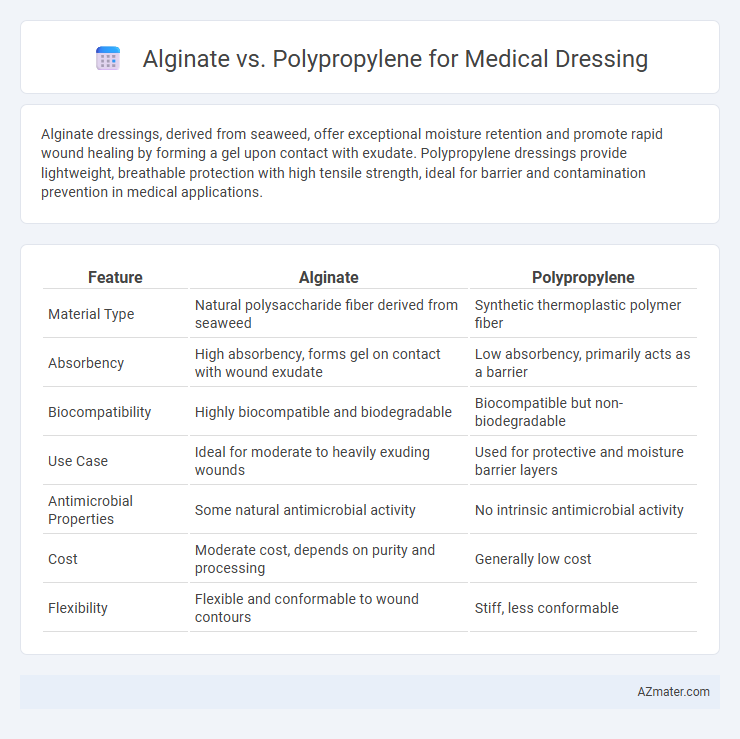Alginate dressings, derived from seaweed, offer exceptional moisture retention and promote rapid wound healing by forming a gel upon contact with exudate. Polypropylene dressings provide lightweight, breathable protection with high tensile strength, ideal for barrier and contamination prevention in medical applications.
Table of Comparison
| Feature | Alginate | Polypropylene |
|---|---|---|
| Material Type | Natural polysaccharide fiber derived from seaweed | Synthetic thermoplastic polymer fiber |
| Absorbency | High absorbency, forms gel on contact with wound exudate | Low absorbency, primarily acts as a barrier |
| Biocompatibility | Highly biocompatible and biodegradable | Biocompatible but non-biodegradable |
| Use Case | Ideal for moderate to heavily exuding wounds | Used for protective and moisture barrier layers |
| Antimicrobial Properties | Some natural antimicrobial activity | No intrinsic antimicrobial activity |
| Cost | Moderate cost, depends on purity and processing | Generally low cost |
| Flexibility | Flexible and conformable to wound contours | Stiff, less conformable |
Understanding Alginate and Polypropylene Dressings
Alginate dressings, derived from seaweed, are highly absorbent and form a gel on contact with wound exudate, promoting a moist healing environment ideal for moderate to heavily exuding wounds. Polypropylene dressings, made from a synthetic polymer, offer a non-absorbent barrier that provides protection and allows breathability, making them suitable for dry or minimally exuding wounds. Understanding the distinct properties of alginate's bioactive moisture management versus polypropylene's protective, non-absorbent nature is crucial for selecting the appropriate medical dressing based on wound type and healing requirements.
Key Material Properties: Alginate vs Polypropylene
Alginate dressings are highly absorbent, biodegradable, and promote hemostasis through calcium ion exchange, making them ideal for managing moderate to heavy exudate in wounds. Polypropylene dressings offer excellent tensile strength, chemical resistance, and are hydrophobic, providing a protective barrier while maintaining breathability. The choice between alginate and polypropylene depends on the wound type and healing requirements, with alginate favoring moist healing environments and polypropylene prioritizing durability and permeability.
Absorption Capabilities and Fluid Management
Alginate dressings, derived from seaweed, exhibit superior absorption capabilities due to their ability to form a gel upon contact with wound exudate, effectively managing moderate to heavy fluid levels and maintaining a moist healing environment. Polypropylene dressings, made from synthetic polymer fibers, provide moderate absorption but primarily serve as a protective barrier with enhanced breathability and fluid resistance rather than high fluid retention. Alginate's superior fluid management makes it preferable for wounds with substantial exudate, while polypropylene is suited for dry or minimally exuding wounds requiring breathability and protection.
Biocompatibility and Patient Safety
Alginate dressings exhibit superior biocompatibility due to their natural polysaccharide composition derived from seaweed, promoting moisture retention and reducing irritation on sensitive wounds. Polypropylene dressings, while durable and cost-effective, may pose higher risks of allergic reactions or skin maceration due to their synthetic nature and limited moisture management. Prioritizing alginate materials significantly enhances patient safety by minimizing inflammation and supporting a conducive healing environment.
Wound Healing Efficacy
Alginate dressings excel in wound healing efficacy due to their high absorbency and ability to maintain a moist environment that promotes faster tissue regeneration and reduces infection risk. Polypropylene dressings provide excellent breathability and barrier protection but lack the superior moisture retention and bioactive properties essential for optimal healing of exuding wounds. Clinical studies indicate alginate's enhanced capability in accelerating granulation and epithelialization compared to polypropylene, making it more effective for managing moderate to heavily exuding wounds.
Infection Control and Antimicrobial Features
Alginate dressings, derived from seaweed, are highly absorbent and promote a moist wound environment, which helps in effective infection control by trapping exudates and minimizing bacterial proliferation. Polypropylene dressings, composed of synthetic fibers, provide a protective barrier but lack intrinsic antimicrobial properties, making them less effective in managing infection compared to alginate. The antimicrobial features of alginate can be enhanced with additives like silver, offering superior efficacy in reducing bioburden and promoting faster wound healing versus polypropylene dressings.
Comfort, Conformability, and Ease of Application
Alginate dressings, derived from seaweed fibers, offer superior comfort through excellent moisture absorption and a soft, gel-like consistency that minimizes irritation on wounds. Polypropylene dressings provide high conformability and lightweight protection but may lack the moisture management capabilities of alginate, potentially affecting overall wound comfort. Ease of application favors alginate for exudative wounds due to its moldability and adherence, whereas polypropylene is simpler for dry wounds requiring non-absorbent coverage.
Cost-Effectiveness and Availability
Alginate dressings, derived from seaweed, offer superior absorbency and biodegradability but tend to be more expensive due to raw material costs and processing requirements. Polypropylene dressings, made from synthetic polymers, provide cost-effective options with widespread availability in medical supply chains, though they lack the natural moisture-retentive properties of alginates. Hospitals balancing budget constraints and wound care efficacy often prefer polypropylene for routine use, while alginate is reserved for complex or heavily exuding wounds where higher performance justifies increased expense.
Clinical Indications and Preferred Use Cases
Alginate dressings are highly absorbent and ideal for managing moderate to heavily exuding wounds such as diabetic ulcers, pressure sores, and surgical wounds, promoting a moist healing environment with minimal trauma upon removal. Polypropylene dressings offer a non-adherent, breathable barrier suitable for protecting superficial wounds, abrasions, and as secondary dressings, where low exudate management and skin protection are priorities. Clinical preference favors alginate for wounds requiring significant fluid absorption and polypropylene for dry or low-exudate wounds needing a protective, non-traumatic covering.
Choosing the Right Dressing: Alginate or Polypropylene?
Alginate dressings are highly absorbent, ideal for managing moderate to heavy exudate in wounds such as ulcers and surgical sites, while polypropylene dressings offer a non-absorbent, breathable barrier suitable for dry or minimally exuding wounds. Selecting the right dressing depends on wound moisture level, as alginate promotes faster healing in moist environments by forming a gel, whereas polypropylene prevents contamination and maintains dryness. Understanding wound characteristics and healing stages ensures optimal choice between alginate's hemostatic properties and polypropylene's protective, hypoallergenic nature.

Infographic: Alginate vs Polypropylene for Medical dressing
 azmater.com
azmater.com